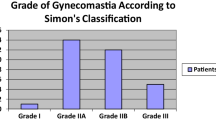Abstract.
Introduction: A number of techniques are available for the correction of gynecomastia. Nonscarring sparing methods are preferred, and the minimally invasive technique is to use liposuction for the gland and the fatty tissue exclusively. In this retrospective study we present our experience with a combination of liposuction and subsequent resection of the remaining gland. Methods: Sixty-two patients (112 breasts) were surgically treated for gynecomastia from January 1996 and September 2000. From 1996 to 1997 all patients suffering from gynecomastia grade Simon I–II were treated by the method described by Rosenberg and Stark, which is exclusively suction of the fatty and glandular tissue. In a retrospective chart study a high recurrence rate was found in these patients. Subsequently we changed our techique to liposuction of the fatty tissue followed by sharp excision of the glandular tissue through the incision made for the liposuction cannula in the submammary fold. Results: Suction alone was not sufficient to remove the glandular tissue; the rate of recurrence after suction was 35 %. When sharp resection of the glandular tissue was carried out after the liposuction the recurrence rate dropped to under 10 %. In total our complication rate was 50 % including minor sequelae. The most frequent complication was unacceptable scarring of the nipple-areola complex. Hypesthesia of the nipple-areola occurred in 13.4 % of the patients. Conclusion: The combination of liposuction and resection of the glandular tissue is a minimally invasive correction that can be used in all cases of gynecomastia grade Simon I–II.
Zusammenfassung.
Einleitung: Für die Behandlung der Gynäkomastie existieren eine Vielzahl von Methoden. Narbensparende Techniken werden bevorzugt, die am geringsten invasive Technik ist die ausschließliche Absaugung des Fett- und Brustdrüsengewebes. In dieser retrospktiven Untersuchung wird von unseren Erfahrungen mit der Kombination von Liposuktion und anschließender Resektion des Restbrustdrüsenkörpers berichtet. Methodik: 62 Patienten (112 Brüste) mit Gynäkomastie wurden von Januar 1996 bis September 2000 chirurgisch behandelt. Von 1996–1997 wurden alle Patienten mit einer Gynäkomastie Grad I oder II nach Simon nach der Methode von Rosenberg und Stark [17, 22] alleine durch eine „Gynäkosuktion“ behandelt. In der retrospektiven Untersuchung der Ergebnisse fiel eine hohe Rezidivneigung dieser Patienten auf. Daher stellten wir die Technik um und resezierten nach der Liposuktion der lipomatösen Anteile der Gynäkomastie den Brustdrüsenkörper über eine geringe Schnitterweiterung der Stichincision für die Liposuktionskanüle (Exhäresetechnik). Ergebnisse: Die alleinige Liposuktion konnte den Brustdrüsenkörper nicht ausreichend entfernen, die Rezidivrate lag nach diesen Eingriffen bei 35 %. Wenn nach der Liposuktion der lipomatösen Anteile eine subcutane Mastektomie des Restdrüsenkörpers angeschlossen wurde sank die Rezidivrate auf unter 10 %. Insgesamt hatten wir in unserem Patientengut eine Komplikationsrate von 50 %, wenn alle, auch geringe ungewünschte Folgen eingerechnet werden. Die Hauptkomplikation war eine narbige Einziehung der Mamille. Eine bleibende Gefühlsstörung der Mamille trat bei 13,4 % der Patienten auf. Schlussfolgerung: Mit der Kombination von Liposuktion und Exhärese ist eine minimal-invasive, narbensparende Korrektur bei allen Gynäkomastien – zumindest der Stadien I–II – möglich.
Similar content being viewed by others
Author information
Authors and Affiliations
Rights and permissions
About this article
Cite this article
Voigt, M., Walgenbach, KJ., Andree, C. et al. Minimal-invasive, chirurgische Therapie der Gynäkomastie Liposuktion und Exhäresetechnik. Chirurg 72, 1190–1195 (2001). https://doi.org/10.1007/s001040170059
Issue Date:
DOI: https://doi.org/10.1007/s001040170059




